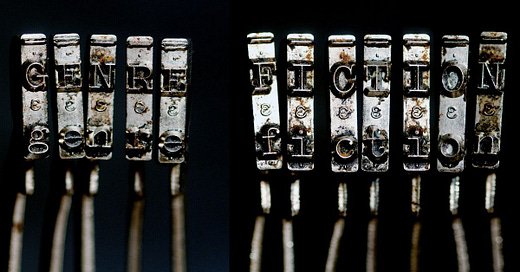I’ve always been drawn to genre fiction, though I didn’t have a name for it at the time. I just knew what I liked: stories with a flicker of magic, a whiff of something uncanny, or the quiet thrum of faraway planets. I grew up on Star Trek and Terrahawks, devoured The Twilight Zone, and sought out anything that promised mystery with a side of wonder.
Back then, “genre” was just a shelf label at the local library. To me, those stories were portals — sometimes to other worlds, sometimes to truths we’re not quite ready to look at directly. I didn’t care what they were called, only that they satisfied the hunger I had for the strange and the possible.
It wasn’t until I began writing seriously that genre stopped being just a flavour and started looking more like a guidebook. Suddenly, it mattered where a story lived — what container it came in. That knowledge helped me write with more direction… and also gave me more reasons to overthink.
Because here’s the thing: stories don’t always like to stay in containers.
As a writer, bringing what a story wants to be with what a genre expects it to be is a maddening dance. And yet, this tension is part of what makes genre fiction so rich. When done well, it holds both structure and soul. That’s what I do as a book coach - I help genre writers craft stories with emotional impact.
Once my stories got out into the world, I discovered something I hadn’t expected.
Genre fiction, it turns out, has a bit of a reputation problem.
Some people treat it like literary fiction’s embarrassing cousin — fun at parties, but not the kind you introduce to serious readers. Even excellent genre fiction gets relabelled as ‘literary’ to be taken seriously. As if the label somehow bestows depth the story didn’t already possess.
A friend recently tried to buy a translation of Sunrise on the Reaping by Suzanne Collins. The bookseller turned up their nose and said, “We don’t carry those kinds of books.”
Excuse me?
There is no literary justification for shaming someone’s reading taste, especially when that taste is paying the publishing bills. And that’s not a figure of speech: genre fiction fuels the industry. According to Circana, fantasy, sci-fi, and romance are still driving the US market. That revenue often subsidises the quieter, riskier titles, including the literary ones that need more time to find their audience. Which, let’s be honest, is a beautiful symbiosis. But let’s not pretend one side is nobler than the other.
Genre fiction isn’t inferior. It’s different. And writing it? Not easy.
Yes, there are structures and expectations. No, there is no plug-and-play template. Writing genre fiction still means crafting characters who leap off the page, navigating complex arcs, and delivering something emotionally resonant within familiar frames. The best stories don’t just entertain — they interrogate, reveal, haunt.
Think: The Silence of the Lambs. The Handmaid’s Tale. Mexican Gothic. Red Rising. The Miniaturist. Or anything by Lisa Jewell, Sarah Hilary, or Doug Johnstone. These aren’t guilty pleasures. They’re literary bursts — dressed for the popular shelf.
So maybe, instead of measuring genre fiction against literary fiction like it’s the grown-up in the room, we could admit that readers are savvier than we give them credit for. They’re choosing stories that make them feel something, no matter the container.
And really, isn’t that the point?
If you're a genre fiction writer chasing both emotional depth and structural clarity, I’m here to help. I work with authors who want their stories to matter and to leave a mark. Let’s make sure your story doesn’t just fit the shelf, but earns its place in a reader’s heart.




